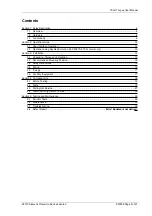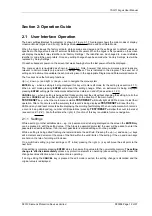
7SG11 Argus User Manual
©2013 Siemens Protection Devices Limited
P20006 Page 12 of 37
Section 2: Operation Guide
2.1 User Interface Operation
The basic settings/displays flow diagram is shown in Figure 2-1. This diagram shows the main modes of display:
Linesman Mode (Argus 4 and 6 only), Settings Mode, Instrument Mode and Fault Data Mode.
When the Argus leaves the factory all data storage areas are cleared and the settings set to default values as
specified in the Argus Overcurrent Technical Reference document. When the Argus is first powered-on the screen
will display the default relay identifier and ‘Factory Settings’. The identifier can be changed to a user definable
identifier or code if the user prefers. Once any setting changes have been made the ‘Factory Settings’ text will be
replaced by ‘Relay Settings’.
On each subsequent power-on the screen that was showing before the last power-off will be displayed.
The menu system is navigated as shown in Figure 2-1. Note, however that some sub-menus and screens are
relevant to certain models only and will not always appear. This is indicated in the diagram. The exact list of
settings and instruments available in each model is given in the appropriate Diagrams and Parameters document.
The five keys have the following functions:
Up (
), down (
) and right (
) keys – used to navigate the menu system
ENTER
key – when a setting is being displayed this key will enter edit mode for the setting (see section 2.1.1).
When in edit mode pressing
ENTER
will accept the setting change. When an instrument is being displayed
pressing
ENTER
will toggle the instruments default screen status on and off (see section 2.1.2.1).
CANCEL
key – when a setting is being edited this key will cancel the edit without changing the setting. At all other
positions
CANCEL
will move back up the menu system (in the direction of the main menu).
TEST/RESET
key – when the main menu is visible
TEST/RESET
will briefly light all
LEDs
in order to test their
operation. After a trip occurs and the summary fault record is being displayed
TEST/RESET
will reset the trip
LED
and any hand reset contacts before displaying the scrolling fault display. When an instrument which records
a count is being displayed (e.g. number of CB operations) pressing
TEST/RESET
will allow the count to be reset
(see section
At all other times the right
(
)
function of this key is available for menu navigation
.
2.1.1 Settings
While a setting (or other editable value – e.g. in Linesman mode) is being displayed on the screen the
ENTER
key
can be pressed to edit the setting value. If the Argus is password protected the user will be asked to enter the
password as described below. If an incorrect password is entered editing will not be permitted.
While a setting is being edited flashing characters indicate the edit field. Pressing the up (
) and down (
) keys
will increment and decrement the value of the field within the valid limits of the setting. If the up and down keys
are held on the rate of scrolling will increase.
On a multi-field setting (e.g. text settings or CT ratios) pressing the right (
) key will move the edit point to the
next field.
Once editing is complete pressing
ENTER
stores the new setting value into the non-volatile memory.
The setting
change is effective immediately
unless any protection element is operating (above setting) in which case the
change becomes effective when no elements are operating.
If during editing the
CANCEL
key is pressed the edit mode is exited, the setting change is discarded and the
original value is redisplayed.






























